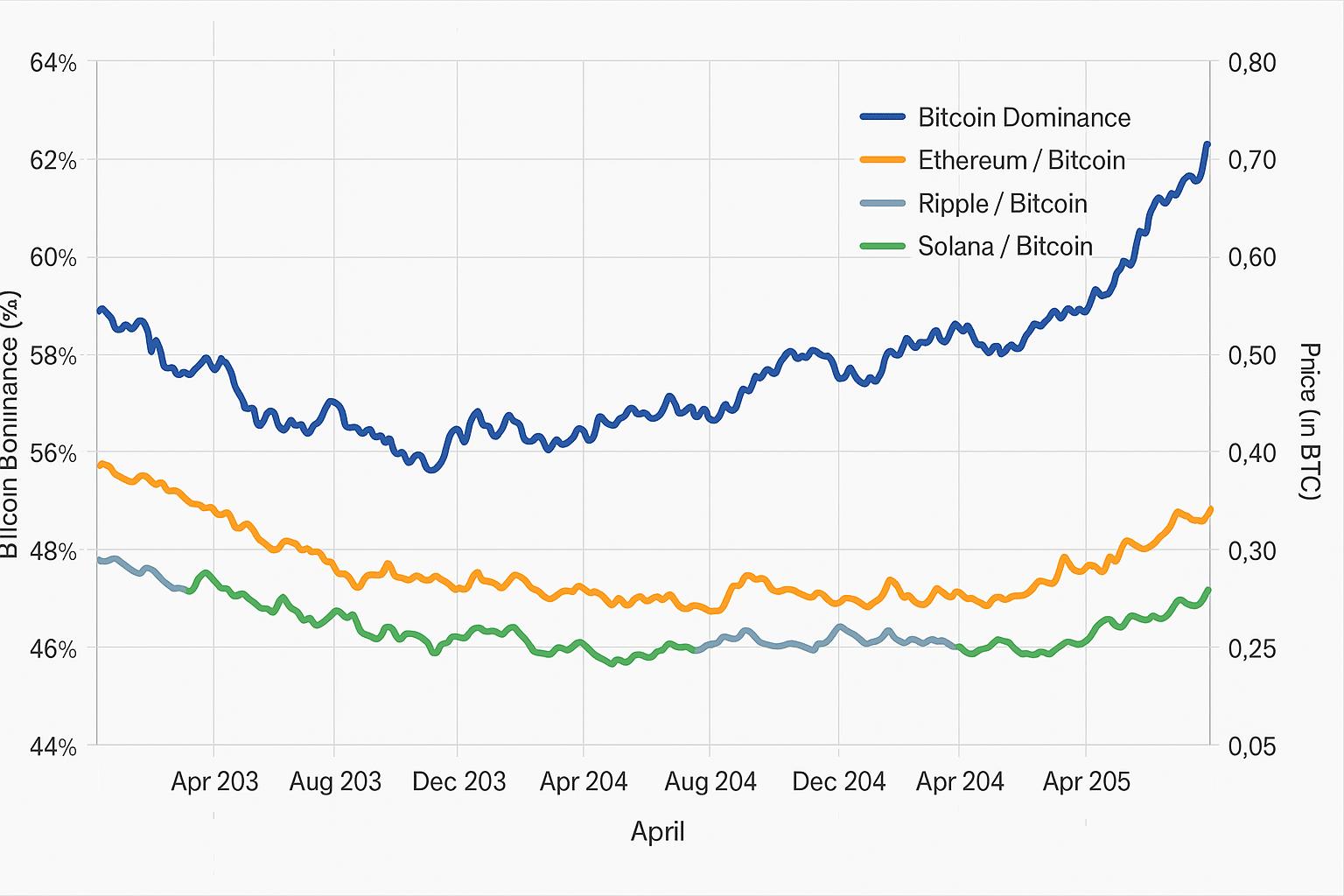As per the current market, a notable trend has emerged: the increasing dominance of Bitcoin (BTC) juxtaposed with the subtle yet significant movements of altcoins striving for independence. This dynamic interplay is reshaping market perceptions and investment strategies.
Bitcoin’s Ascending Dominance
As of early April 2025, Bitcoin’s market dominance has surged to approximately 62.70%, a level reminiscent of its stronghold in early 2021. This resurgence is largely attributed to institutional investors gravitating towards Bitcoin as a perceived safe haven amidst global economic uncertainties. Notably, the introduction of spot Bitcoin ETFs has streamlined access for traditional investors, amplifying capital inflows into BTC.
Altcoins: In Bitcoin’s Shadow
Historically, altcoins have mirrored Bitcoin’s price movements, a phenomenon influenced by high-frequency trading (HFT) algorithms and institutional strategies that tether altcoin valuations to Bitcoin for liquidity and risk management purposes. This synchronization has often relegated altcoins to the background, overshadowed by Bitcoin’s market maneuvers.

Emerging Signs of Decoupling
However, recent analyses suggest a budding decoupling trend. Certain altcoins are exhibiting price movements independent of Bitcoin, hinting at a maturation where these digital assets are evaluated on their intrinsic merits rather than Bitcoin’s trajectory. For instance, tokens like XRP have demonstrated resilience and growth, buoyed by institutional partnerships and unique value propositions.
Institutional Influence and Market Dynamics
The evolving landscape is further shaped by institutional interest extending beyond Bitcoin. Projects with tangible use cases and robust infrastructures are attracting attention, leading to strategic investments in select altcoins. This shift indicates a broader market recognition of the potential harbored within diverse blockchain applications.

Price Overview
To provide a snapshot of the current market standings, here’s a comparative table highlighting the performance of Bitcoin and select altcoins:
| Cryptocurrency | Price (USD) | Market Cap (USD) | 24h Change (%) |
|---|---|---|---|
| Bitcoin (BTC) | $84,000 | $1.58 Trillion | +2.0% |
| Ethereum (ETH) | $2,800 | $336 Billion | -1.5% |
| Ripple (XRP) | $0.85 | $39 Billion | +3.2% |
| Solana (SOL) | $205 | $82 Billion | +5.0% |
Data as of April 3, 2025.
Market Implications
The decoupling of altcoins from Bitcoin’s influence carries profound implications:
Diversification Opportunities: Investors can explore a broader spectrum of assets, mitigating risks associated with a Bitcoin-centric portfolio.
Informed Valuations: Altcoins may be assessed based on individual fundamentals, leading to more accurate valuations and investment decisions.
Market Maturity: A diversified crypto market signifies maturation, with multiple assets contributing to overall market dynamics.
Conclusion
While Bitcoin continues to assert its dominance, the subtle yet discernible shift of altcoins carving independent trajectories underscores the cryptocurrency market’s complexity and dynamism. For investors and enthusiasts alike, staying attuned to these developments is crucial, as they herald a more nuanced and diversified digital asset ecosystem.
FAQs
What does Bitcoin dominance mean?
Bitcoin dominance refers to the percentage of the total cryptocurrency market capitalization that is attributed to Bitcoin. A higher dominance indicates Bitcoin’s larger share relative to other cryptocurrencies.
Why are altcoins correlated with Bitcoin?
Altcoins have historically mirrored Bitcoin due to trading algorithms and institutional strategies that align altcoin prices with Bitcoin for liquidity and risk management.
What signifies altcoins decoupling from Bitcoin?
Decoupling occurs when altcoins exhibit price movements independent of Bitcoin, suggesting they are being valued based on their own fundamentals rather than Bitcoin’s market behavior.
How can investors benefit from altcoin decoupling?
Investors can diversify portfolios by investing in altcoins with strong fundamentals, potentially reducing reliance on Bitcoin’s performance and capturing gains from emerging digital assets.
Glossary of Key Terms
Bitcoin Dominance: The ratio of Bitcoin’s market capitalization to the total cryptocurrency market capitalization.
Altcoins: Cryptocurrencies other than Bitcoin, such as Ethereum, Ripple, and Solana.
Decoupling: The process where altcoins’ price movements become independent of Bitcoin’s price actions.
High-Frequency Trading (HFT): A trading strategy that uses powerful computers to transact a large number of orders at extremely high speeds.
Spot Bitcoin ETF: An exchange-traded fund that directly holds Bitcoin, allowing investors to gain exposure to Bitcoin’s price movements without owning the cryptocurrency itself.
References
Blockchainnews





























